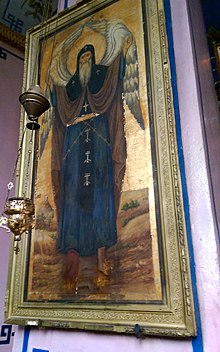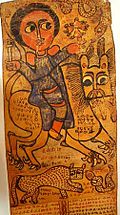Tekle Haymanot
Tekle Haymanot ተክለ ሃይማኖት | |
|---|---|
 Painting of Abune Tekle Haymanot in a publication | |
| The Righteous | |
| Born | 1215 Bulga,Shewa |
| Died | 1313 (aged 97–98) Debre Libanos,Ethiopian Empire |
| Venerated in | Coptic Orthodox Church Ethiopian Orthodox Church Eritrean Orthodox Church Ethiopian Catholic Church Eritrean Catholic Church Coptic Catholic Church |
| Majorshrine | St. Takla Haymanot's Church (Alexandria) Debre Libanos,Ethiopia |
| Feast | 30 August every 24th day of the month (Ethiopian Orthodox) |
| Attributes | Man with wings on his back and only one leg visible |
| Patronage | Ethiopians |
| Part ofa serieson |
| Oriental Orthodoxy |
|---|
 |
| Oriental Orthodox churches |
|
|
Abune Tekle Haymanot(Ge'ez:አቡነ ተክለ ሃይማኖት; known in theCoptic ChurchasSaint Takla Haymanot of Ethiopia;1215 – 1313) was an Ethiopiansaintandmonkmostly venerated as ahermit.He was theAbunaof Ethiopia who founded a major monastery in his native province ofShewa.He is significant for being the only Ethiopian saint popular both amongstEthiopiansand outside that country. Tekle Haymanot "is the only Ethiopian saint celebrated officially in foreign churches such as Rome and Egypt."[1]His feast day is 30 August (Nehasə 24 inEthiopian calendar), and the 24th day of every month in the Ethiopian calendar is dedicated to Tekle Haymanot.[2]
Early life
[edit]Tekle Haymanot was born in Zorare, a district inSelalewhich lies on the eastern edge ofShewa.He was the son of thepriestTsega Zeab (ጸጋ ዘአብ) ( "Grace of God" ) and his wife Egzi'e Haraya ( "Choice of God" ), who is also known as Sarah; Tekle Haymanot was born after his parents, who had failed to have children, pledged their firstborn to God.[3][4]Tekle Haymanot was ethnicallyAmhara,and his 13th-14th centuryhagiographytracesBete Amharaas far back as the mid 9th century AD as a location.[5]
During his youth, Shewa was subject to a number of devastating raids byMatolomi,the pagan king ofDamot,which lay beyond theJamma River.One of Matolomi's most notorious predations was the raid which led to the abduction of Egzi'e Haraya; she is said to have been reunited with Tsega Zeab through the intercession of theArchangel Michael;when Matolomi found out that they were escaping he threw a spear who turned from them to his direction and killed him.[6]There are several traditions like that one, some of less historical value than others, which describe Tekle Haymanot's interactions with King Matolomi.
His father gave Tekle Haymanot their earliest religious instruction; later he was ordained a priest by the Egyptian Bishop Cyril (known as Kirollos in Coptic).
Later career
[edit]The first significant event in his life was when Tekle Haymanot, at the age of 30, travelled north to seek further religious education. His journey took him from Selale toGrarya,then Katata,Damot,Amhara,[6]to end at the monastery ofIyasus Mo'a,who had only a few years before founded a monastery on an island in the middle ofLake Hayqin the district ofAmba Sel(the present-dayAmhara Region). There Tekle Haymanot studied under the abbot for nine years before travelling toTigray,where he visitedAxum,then stayed for a while at the monastery ofDebre Damo,where he studied under Abbot Yohannes, Iyasus Mo'a's spiritual teacher. By this point he had developed a small group of followers, attracted by his reputation.
Eventually, Tekle Haymanot left Debre Damo with his followers to return to Shewa. En route, he stopped at the monastery of Iyasus Mo'a, where tradition states he received the full investiture of an Ethiopian monk'shabit.The historianTaddesse Tamratsees in the existing accounts of this act an attempt by later writers to justify the seniority of the monastery in Lake Hayq over the followers of Tekle Haymanot.[7]
Once in Shewa, he introduced the spirit of renewal that Christianity was experiencing in the northern provinces. He settled in the central area between Selale and Grarya, where he founded in 1284 the monastery of Debre Atsbo (renamed in the 15th centuryDebre Libanos). This monastery became one of the most important religious institutions of Ethiopia, not only founding a number of daughter houses, but itsabbotbecame one of the principal leaders of the Ethiopian Church, called theEchege,second only to theAbuna.
Tekle Haymanot lived for 29 years after the foundation of this monastery, dying in the year before EmperorWedem Araddid; this would date Tekle Haymanot's death to 1313. He was first buried in the cave where he had originally lived as a hermit; almost 60 years later he was reinterred atDebre Libanos.In the 1950s, EmperorHaile Selassieconstructed a new church at Debre Libanos Monastery over the site of the Saint's tomb. It remains a place of pilgrimage and a favored site for burial for many people across Ethiopia.
Later traditions
[edit]
Tekle Haymanot is frequently represented as an old man with wings on his back and only one leg visible. There are a number of explanations for this popular image. C.F. Beckingham and G.W.B. Huntingford recount one story, that the saint "having stood too long for about 34 years, one of his legs broke or cut while Satan was attempting to stop his prayers, whereupon he stood on one foot for 7 years."[8]Paul B. Henze describes his missing leg as appearing as a "severed leg... in the lower left corner discreetly wrapped in a cloth."[9]The travellerThomas Pakenhamlearned from the Prior of Debre Damo how Tekle Haymanot received his wings:
- One day he said he would go to Jerusalem to see theGarden of Gethsemaneand the hill of the skull that is calledGolgotha.But Shaitan (Satan) planned to stop Tekla Haymanot going on his journey to the Holy Land, and he cut the rope which led from the rock to the ground just as Tekla Haymanot started to climb down. Then God gave Tekla Haymanot six wings and he flew down to the valley below... and from that day onwards Teklahaimanot would fly back and forth to Jerusalem above the clouds like an aeroplane.[10]
Many traditions hold that Tekle Haymanot played a significant role inYekuno Amlak's ascension as the restored monarchy of theSolomonic dynasty,[11]following two centuries of rule by theZagwe dynasty,although historians like Taddesse Tamrat believe these are later inventions. (A few older traditions credit Iyasus Mo'a with this honour.)
Another tradition credits Tekle Haymanot as the onlyLek'e P'ap'asof Ethiopia who was born in Ethiopia and who wasEthiopian. The Christian population andBishopsof Ethiopia wanted Tekle Haimanot to become theLek'e P'ap'asof Ethiopia. After the newLek'e P'ap'asAbuna Yohannesfrom Egypt sent by thePatriarch of Alexandriaarrived at Ethiopia he decided to separate: One part of Ethiopia to Tekle Haimanot and one part to himself, but Tekle Haimanot didn't want the high rank asLek'e P'ap'asanymore and retired from his position to become a monk again.[12]
A number ofhagiographiesof this saint have been written. G.W.B. Huntingford mentions two differentgadlat:"one written by Abba Samuel of Waldiba in the first quarter of the 15th century and the other by one Gibra Maskel of Debre Libanos early in the 16th century".[citation needed]E.A. Wallis Budgehas translated a third one, entitledThe Life of Täklä Haymanot,[13]which is attributed to one Täklä Sion. Tesfaye Gebre Mariam adds to these another version, popular at the monastery of Debre Libanos and containing far more details of the saint's life than any other version of thegadla,and which Tesfaye confirmed was written byIchegeYohannis Kema.[1]
See also
[edit]References
[edit]- ^abTesfaye Gebre Mariam,"A Structural Analysis of Gädlä Täklä Haymanot",African Languages and Cultures,10 (1997), p. 184
- ^Donald N. Levine,Wax and Gold: Tradition and Innovation in Ethiopia Culture(Chicago: University Press, 1972), p. 73
- ^G.W.B. Huntingford,The Historical Geography of Ethiopia(London: The British Academy, 1989), The Life of Takla Haymanot in the Version of Dabra Libanos and the Miracles of Takla Haymanot in the Version of Dabra Libanos, and the Book of the Riches of Kings. Translated by E. A. Wallis Budge. London 1906.
- ^G.W.B. Huntingford,The Historical Geography of Ethiopia(London: The British Academy, 1989), p. 69
- ^The Life of Takla Haymanot in the Version of Dabra Libanos and the Miracles of Takla Haymanot in the Version of Dabra Libanos, and the Book of the Riches of Kings. Translated by E. A. Wallis Budge. London 1906.
- ^abTesfaye Gebre Mariam, "Structural Analysis", p. 188
- ^Taddasse Tamrat,Church and State in Ethiopia (1270–1527)(Oxford, 1972), pp. 160-189
- ^C.F. Beckingham and G.W.B. Huntingford, trans.The Prester John of the Indiesby Alfonso Alvarez, (Cambridge:Hakluyt Society,1961), p. 394n.
- ^Paul B. Henze,Layers of Time: A History of Ethiopia(New York: Palgrave, 2000), p. 63
- ^Pakenham,The Mountains of Rasselas(New York: Reynal, 1959), p. 84
- ^Henze,Layers of Time,p. 62n.50
- ^E.A. Wallis Budge,A History of Ethiopia: Nubia and Abyssinia,1928 (Oosterhout, the Netherlands: Anthropological Publications, 1970), p. 286
- ^The Life of Takla Haymanot in the Version of Dabra Libanos and the Miracles of Takla Haymanot in the Version of Dabra Libanos, and the Book of the Riches of Kings. Translated by E. A. Wallis Budge. London 1906.

